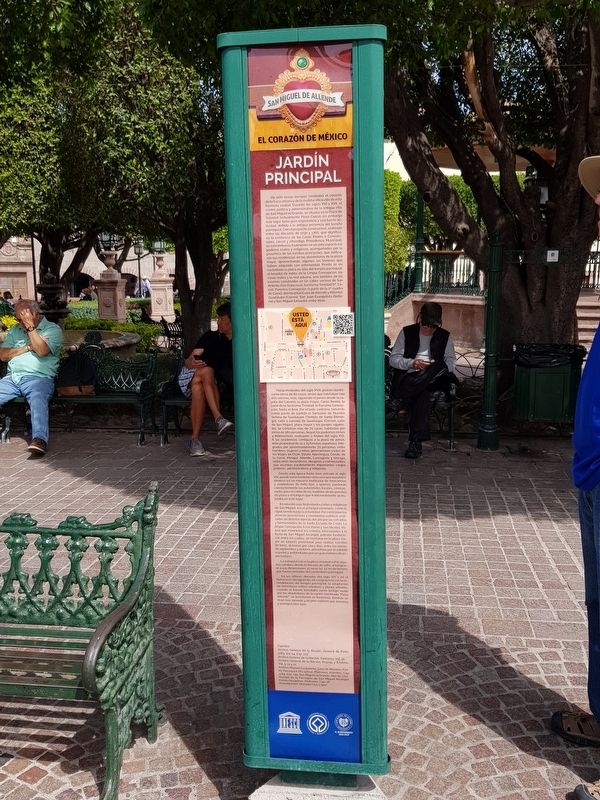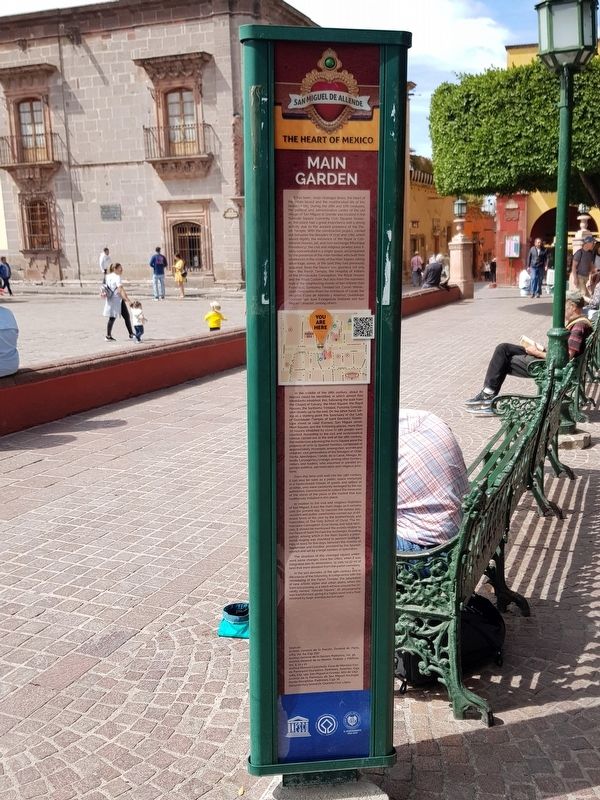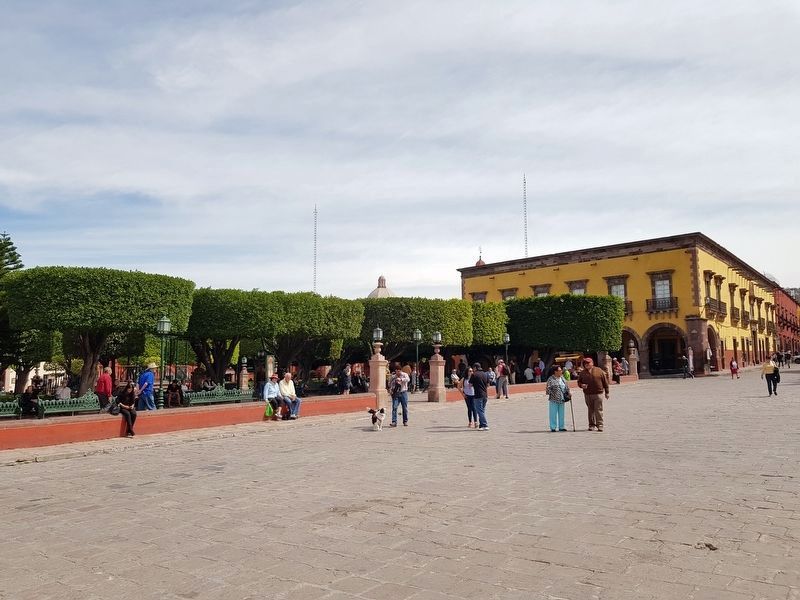San Miguel de Allende, Guanajuato, Mexico — The Central Highlands (North America)
Main Garden
San Miguel de Allende - El Corazón de México
Ha sido desde tiempos virreinales el corazón de la traza urbana y de la multifacética vida de esta hermosa ciudad. Durante los siglos XVI y XVII, el centro político y administrativo de la antigua villa de San Miguel el Grande, se situaba en la Plaza de Soledad (actualmente Plaza Cívica), sin embargo este lugar tenía gran importancia y una fuerte actividad debido a la antigua presencia del templo parroquial. Con el proyecto constructivo, realizado entre las décadas de 1730 y 1760, que dignificaría la existencia de las Casas Reales o Consistoriales, cárcel y alhóndiga (Presidencia Municipal), se concentraron finalmente en un solo espacio los poderes civiles y religiosos, acompañados por la presencia de familias principales, que edificaron sus residencias en los alrededores de la plaza mayor, aprovechando, algunos los terrenos que habían adquirido con anterioridad. Pronto se vio custodiada la plaza no sólo del templo parroquial, el hospital de indios de la Limpia Concepción, las casas reales y la real aduana, sino también de las casonas constriuidas en las calles vecinas de San Antonio (San Francisco), Santísima Trinidad (1ª. Canal), Purísima Concepción (a partir de la 2ª cuadra de Canal), del Hospital (Cuna de Allende y Aldama), Guadalupe (Correo), San Juan Evangelista (Sollano) y San Miguel (Umarán), entre otras.
Hacia mediados del siglo XVIII, podían identificarse cerca de 80 casas, en las que habitaban casi 600 vecinos, esto, siguiendo el paseo desde la capilla del Calvario, la plaza mayor, Casas Reales, la calle de la Santísima Trinidad, la Purísima Concepción, hasta el final. Por el lado contrario, tomando como punto de partida el Santuario de Nuestra Señora de Guadalupe (Correo), calle de San Miguel, plaza mayor y los parajes siguientes, se contaban más de 70 casas, habitadas por cerca de 580 personas. Según los padrones civiles y eclesiásticas realizados a finales del siglo XVI-II, las residencias contiguas a la plaza de armas, eran propiedad de 12 a 15 familias españolas, integradas por aproximadamente 70 personas, entre hombres, mujeres y niños, generaciones vastas de los linajes de Ocón, Dávila, Apesteguia, Conde, de la Canal, Meogui, Allende, Lanzagorta y Unzaga, entre otros hacenderos, obrajeros y comerciantes, que asumían paralelamente importantes cargos políticos, administrativos y religiosos.
Desde esta época hasta bien entrado el siglo XIX, puede verse también como un espacio público inmeros en un mosaico multicolor de mercancías y vendedores de todo tipo, a quienes asediarion constantemente las autoridades fiscales, comisionadas para el cobro de las medidas de los puestos de plaza o el tianguis que tradicionalmente se instalaba en este lugar.
En relación a las festividades civiles y religiosas de San Miguel, era el principal escenario, como lo sigue siendo hasta la actualidad. Por mencionar las diversas procesiones y ceremonias públicas realizadas en distintas épocas del año por las cofradías y hermandades de la San Escuela de Cristo, La Limpia Concepción, Ecce Homo y San Nicolás. Habría que mencionar los eventos relacionados a la fiesta de San Miguel Arcangel, patrono fundacional, entre los cuales, se montaba en la plaza mayor un tablado provisional para realizar corridas de toros, al menos por cinco días, entre los meses de septiembre y octubre, presididas por el cabildo español y ambientadas por un gran número de espectadores.
La estructura de esta plaza virreinal sufrío algunos cambios desde la década de 1780, al integrarse a sus dimensiones 15 varas (12.57 m) de terreno que fueron donadas del cementerio parroquial.
En las últimas décadas del siglo XIX y en el transcurso del siguiente, en congruencia con la remodelación del templo parroquial, la adaptación de novedosos estilos artísticos y planes urbanos, cuando el tranvía transitaba como testigo mudo por los alrededores de la recién nombrada
“Plaza Allende”, se transformó su fisonomía, dándole un nivel más elevado y un piso cubierto por enormes y ennegrecidas lajas.
Fuentes:
Archivo General de la Nación, General de Parte, 1783m Vol. 64, Exp. 207.
Archivo General de la Nación, Padrones, Vol. 36
Archivo General de la Nación, Propios y Arbitrios, Vol. 9, 12 y 21.
Archivo Manuel Castañeda, Casa de Morelos, Fondo Parroquial Disciplinar, Padrones, Asientos, Caja 1284, Exp. 149, San Miguel el Grande, Año de 1747
Archivo de la Parroquia de San Miguel Árcangel, Fondo Disciplinar, Padrones, Caja 76
Investigación: Graciela Cruz López.
Main Garden
It has been since viceregal times, the heart of the urban layout and the multifaceted life of this beautiful city. During the 16th and 17th centuries, the political and administrative center of the old village of San Miguel el Grande was located in the Solitude Square (currently Civic Square): however, this place had a great importance and a strong activity due to the ancient presence of the Parish Temple. With the constructive project, carried out between the decades of 1730 and 1760, which would dignify the existence of the Royal or Consistorial Houses, jail, and corn exchange (Municipal Presidency), the civil and religious powers were finally concentrated in a single space, accompanied by the presence of the main families who built their residences in the vicinity of the Main Square, taking advantage, some, of the land they had previously acquired. Soon the Square was guarded, not only from the Parish Temple, the Hospital of Indians of the Immaculate Conception, the Royal Houses and the Royal Custom, but also from the mansions built in the neighboring streets of San Antonio (San Francisco), Santísima Trinidad (1st. Canal), Immaculate Conception (from the 2nd block of Canal), the Hospital (Cuna de Allende y Aldama), Guadalupe (Correo), San Juan Evangelista (Sollano) and San Miguel (Umarán), among others.
In the middle of the 18th century, about 80 houses could be identified, in which almost 600 inhabitants inhabited, this, following the walk from the Chapel of Calvary, the Main Square, the Royal Houses, the Santísima Trinidad, Purísima Concepción streets up to the end. On the other hand, taking as a starting point the Sanctuary of Our Lady of Guadalupe (Temple of Saint Dominic), Guadalupe street or road (Correo), San Miguel street, Main Square, and the following places, more than 70 houses inhabited by close to 580 people were counted. According to the civil and ecclesiastical census carried out at the end of the 18th century, the residences adjoining the Arms Square were the property of 12 to 15 Spanish families, composed of approximately 70 people, among men, women and children, vast generations of the lineages of Ocón, Dávila, Apesteguia, Conde, de la Canal, Meogui, Allende, Lanzagorta y Unzaga, among other farmers, millers and traders, who assumed in parallel important political, administrative and religious positions.
From this time until well into the 19th century, it can also be seen as a public space immersed in a multicolored mosaic of goods and sellers of all kinds, who were constantly besieged by the tax authorities, commissioned to collect the measures of the stores of the plaza or the market that was traditionally installed in this place.
In relation to the civil and religious festivities of San Miguel, it was the main stage, as it remains until the present day. To mention the various processions and public ceremonies carried out at different times of the year by the brotherhoods and fraternities of The Holy School of Christ, The Immaculate Conception, Ecce Homo, and Saint Nicholas. It should be mentioned the events related to the Feast of Saint Michael the Archangel, founding patron, among which in the Main Square a provisional staging was mounted to perform bullfightings, at least for five days, between the months of September and October, presided by the Spanish council and set by a large number of spectators.
In the last decades of the 19th century and in the course of the following, in congruence with the remodeling of the Parish Temple, the adaptation of new artistic styles and urban plans, when the tram was passing as a silent witness around the recently named “Allende Square”, its physiognomy was transformed, giving it a higher level and a floor covered by huge and blackened slabs.
Sources repeated in Spanish
Documentary research: Graciela Cruz López
Topics. This historical marker is listed in these topic lists: Churches & Religion • Colonial Era • Man-Made Features • Parks & Recreational Areas. A significant historical year for this entry is 1730.
Location. 20° 54.848′ N, 100° 44.626′ W. Marker is in San Miguel de Allende, Guanajuato. Marker is on Correo just east of Cuna de Allende, on the left when traveling east. The marker is along the southern portion of the Central Park (or Main Garden) of San Miguel de Allende. Touch for map. Marker is in this post office area: San Miguel de Allende GTO 37700, Mexico. Touch for directions.
Other nearby markers. At least 8 other markers are within walking distance of this marker. Parish of Saint Michael the Archangel (within shouting distance of this marker); Friar Juan de San Miguel (within shouting distance of this marker); First Independent Municipality of Mexico (within shouting distance of this marker); Birthplace of Ignacio Allende (within shouting distance of this marker); Monument to José Diez de Sollano y Dávalos (within shouting distance of this marker); Master Builder Ceferino Gutiérrez Muñóz (within shouting distance of this marker); House of the Primogeniture of de la Canal (within shouting distance of this marker); Narciso María Loreto de la Canal (within shouting distance of this marker). Touch for a list and map of all markers in San Miguel de Allende.
Credits. This page was last revised on September 1, 2020. It was originally submitted on March 31, 2019, by J. Makali Bruton of Accra, Ghana. This page has been viewed 153 times since then and 6 times this year. Photos: 1, 2, 3. submitted on March 31, 2019, by J. Makali Bruton of Accra, Ghana.


